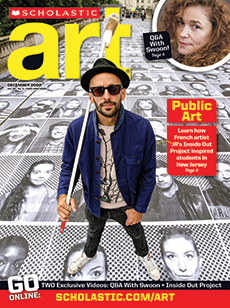Has a teacher ever asked you to find your voice as a writer? Perhaps you’re direct and to the point. Or descriptive and dreamy. When people read one of your stories, they immediately know you wrote it.
Artists can have a voice too. It’s called a visual voice. When you have a strong visual voice, your art has a style that is recognizably yours. You develop your visual voice the same way you would with writing—by exploring different techniques, dropping what you don’t like, keeping what you do, and making it yours.
The artists featured here knew that just as with a journal for writing, a sketchbook is a great place to find your visual voice.
Has a teacher ever asked you to find your voice in your writing? What they meant was for you to develop a unique style that’s all yours. For example, maybe you’re bold and honest. Or detailed and dreamy.
Artists have a voice too. It’s called a visual voice. When you have a strong visual voice, your art has a style that viewers know is yours. You can explore different methods to find what is right for your visual voice.
The artists whose work is shown here knew that a sketchbook is a great place to find your visual voice.
